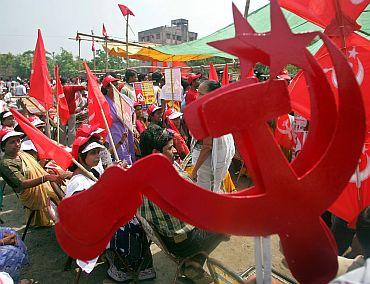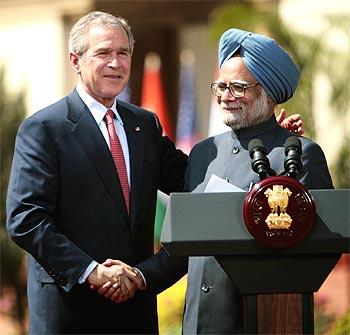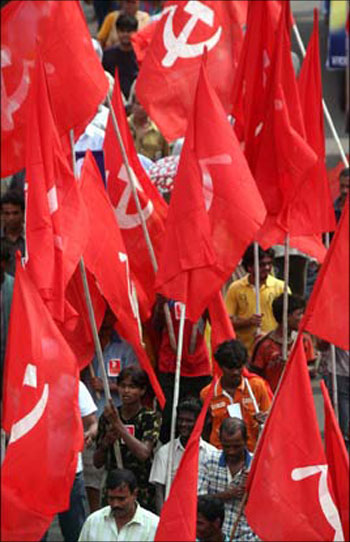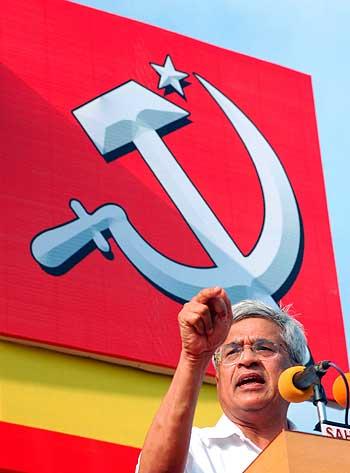
Building grassroots people's movements is the only way forward for the Left, says Praful Bidwai
The message from the just-concluded congresses of India's mainstream Left parties, the Communist Party of India-Marxist and Communist Party of India, is that they are down, not out -- despite their stunning election defeats since 2009. They are honest enough to admit they are in decline and crisis, and must revise their ideology and political strategy. But they are hesitant to do so radically enough. Unless they gather the gumption to go radical, their crisis is likely to deepen.
Party congresses, usually held every three years, are the Communist parties' highest decision-making bodies, which outline their analysis of national and international issues and lay down the political line. These were the first congresses to be held since the last Lok Sabha election, which saw the Left's tally plunge from 60 to 24 seats, followed by its comprehensive rout in West Bengal and poor showing in the Kerala assembly elections.
The Indian Left, especially the CPI-M -- the world's biggest Communist party outside China -- stands at a fork in history. If it regains its relevance by relating to the popular masses' struggles for a life with dignity and justice, and for social emancipation, it could have a bright future. The present situation, in which both the Congress and the Bharatiya Janata Party are losing ground, and no national-level alternative has emerged, favours the Left.
But if the Left remains stuck in jaded ways of thinking, and fails to set ambitious goals, it will lose appeal until its decline becomes irreversible. That's the road to extinction taken by a majority of the world's Communist parties' after the collapse of the Soviet Union.
...

The CPI, smaller and much more self-critical of the two parties, was frank in admitting that it got alienated from the working people because it failed to defend their livelihood concerns and followed elitist policies. It resolved to participate in and lead people's grassroots struggles. It also accomplished a much-needed leadership transition with its highly regarded general secretary A B Bardhan handing over charge to his deputy Suravaram Sudhakar Reddy.
However, the CPM was reluctant to come out of its "comfort zone" and confront the truth. It papered over anomalies and contradictions in its political line, which, among other things, impelled it to withdraw support to the United Progressive Alliance in 2008 and squander a unique opportunity to influence state policy by negotiating a common programme with the ruling coalition in return for "outside support".
The CPI-M also showed itself vulnerable to unhealthy factional pressures. Veteran popular leader V S Achuthanandan was dropped from the politburo. But former West Bengal Chief Minister Buddhadeb Bhattacharjee was retained although he defied the party leadership by boycotting all politburo and central committee meetings held outside Kolkata, and not attending the party congress.
Achuthanandan, who very nearly won the assembly elections for the Left, was excluded at the behest of Kerala party secretary Pinarayee Vijayan. Vijayan is known for his conservative politics and opened the state CPI-M to elite influences, evident in the far-from-frugal arrangements for the Kozhikode congress, with a Rs 10-crore budget.
Bhattacharjee, on the other hand, was allowed to continue in the 15-member politburo to placate the Bengal unit, which was greatly upset with the central leadership for withdrawing support to UPA-I. This cemented an alliance between the Congress and Mamata Banerjee's Trinamool Congress, which trounced the Left Front in the Lok Sabha and assembly elections.
...

The Left, led by the CPI-M, withdrew support on the issue of the US-India nuclear deal, which failed to strike a chord with its core constituency and sympathisers, leave alone ordinary people. Breaking the outside support arrangement with the UPA was in some ways as great a mistake as denying the late Jyoti Basu a chance to lead the United Front government in 1996, which he was invited to do as its most eminent consensus candidate. Basu called this a "historic blunder".
The Left pulled out support at a remarkably inopportune time, in July 2008, well after the UPA had taken the deal to the International Atomic Energy Agency for its endorsement, and put it on 'auto pilot', i.e. outside the Left's control.
The UPA picked up the gauntlet thrown down by the Left and brought in a vote of confidence in Parliament, which it won with an impressive margin thanks to unprincipled support from the Samajwadi Party.
It's true that Dr Manmohan Singh, obsessed with the nuclear deal, played dirty with the Left by going back on his promise to secure its consent before pushing the agreement towards completion.
Yet the fact is, the Left was politically isolated. Its critique of the deal was excessively focussed on its link to a strategic partnership with the US. But this lacked credibility and coherence. It didn't even mention the deal's implications for legitimising India's -- and the Great Powers', in particular the US's -- nuclear weapons, and its uncritical promotion of nuclear power generation.
The Left cut an even sorrier figure by forming a despicably opportunist parody of a "third front" for the ensuing 2009 Lok Sabha election with people like Mayawati, Om Prakash Chautala and Chandrababu Naidu, all former BJP allies. The front very nearly disintegrated even before the elections. It lost the elections -- and the Left its credibility. The whole episode should have been discussed threadbare.
However, the CPI-M congress reached an awkward compromise by agreeing that the withdrawal of support was justified, but the timing wasn't: support should have been withdrawn in October-November 2007, before the UPA government approached the IAEA. This pleased the party's West Bengal unit to an extent, while letting the central leadership off the hook.
...

In reality, however, the CPI-M was in no position to confront the UPA in late 2007. Singur and Nandigram had become household names exemplifying the Left's betrayal of its own core support-base. And the CPI-M had become vulnerable to a destabilisation of its state government because its cadres had just conducted a violent operation to 'recapture' Nandigram from those protesting against forcible land acquisition for a huge chemical industry hub.
At the root of the crisis over the nuclear deal was not just the CPI-M leadership's miscalculation in confronting the UPA on foreign policy and strategic issues, but its embrace in West Bengal of the same neo-liberal policies, with their slavish promotion of corporate-led industrialisation at the cost of the public, for which it rightly pilloried the UPA government at the national level.
The Kozhikode compromise over the nuclear deal and Left-UPA relations was thus a classic case of refusing to learn from past mistakes, and instead adopting a false please-all policy. That's not what genuine self-criticism is about, and that's not how a healthy, wholesome new approach can evolve.
At the Kozhikode congress, the CPI-M adopted an ideological resolution which falls well short of understanding the contemporary world as well as the great flaws of the Stalinist tradition to which it belongs. Nor did it attempt to understand the importance of the new social movements and political mobilisations that are sweeping the world, including Latin America, where novel forms of government based on civil society and popular movements have emerged.
The party continues to call China a socialist country (with some minor deviations) despite the fact that it is a quintessentially capitalist economy, which follows the logic of capital accumulation and exploitation of labour, and provides the greatest thrust among all the countries of the world to capitalist globalisation and replication of the neo-liberal model. The official line on China faced stiff opposition from many delegates. It nevertheless prevailed.
...

The CPI-M also adopted an approach which opposes both the Congress for its neo-liberal policies, and the BJP for its neo-liberalism and communalism. General Secretary Prakash Karat says the CPI-M won't support the Congress even to defeat the BJP. The party has, for the moment, abandoned the third front idea for a 'Left and Democratic' alternative.
Yet, all this seems focused mainly on electoral alliances within the parliamentary framework. The point, however, is non-parliamentary mobilisation. The Left cannot grow and rejuvenate itself unless it takes up people's livelihood issues and struggles for the right to food, to safe drinking water, and to health-care, education and employment. This alone can expose the bankruptcy of prevalent mainstream approaches while offering practical radical alternatives.
Logically, the Left should mobilise poor neighbourhoods and picket private schools to admit underprivileged children under the Right to Education Act, upheld by the Supreme Court. It must agitate for the implementation of the conditions, including subsidised treatment for poor patients, under which prime property was transferred and other concessions granted to posh private hospitals like Apollo.
The Left needs to launch mass movements on issues, including inequalities, which agitate the underprivileged and are the centre of their aspirations for a better, more humane life. Precisely such agitations, like the food and land movements, built up the Left in the 1960s. They, not the politics of manoeuvre between bourgeois party-led alliances, hold the key to the Left's growth.
...